Richard Hudnut (1920-1945)
Continued from: Richard Hudnut
Continued onto: Richard Hudnut (post 1945)
The hiatus brought on by the First World War and the post-war slump of the early 1920s was followed by a period of economic growth during which the new owners of Richard Hudnut set about developing the brand and expanding its global reach. By the end of the decade, Richard Hudnut had factories, branch offices or agencies in Europe, Canada, Mexico, South America, Cuba and the Far East (AP&EOR, March 1930) and construction had begun on a new eight-storey factory and loft building at 133 West 18th Street, New York, completed in 1931.
To better service the European market, and provide the United States with products that were more cheaply or conveniently made in France, an office and factory was built at 15 Rue Pagès Suresnes, Paris in 1925. Richard Hudnut followed this by opening a retail store on the fashionable Rue de la Paix in Paris in 1927. This allowed the company to put Paris in its advertising, complementing the flagship New York salon, moved to 392 Fifth Avenue in 1921.
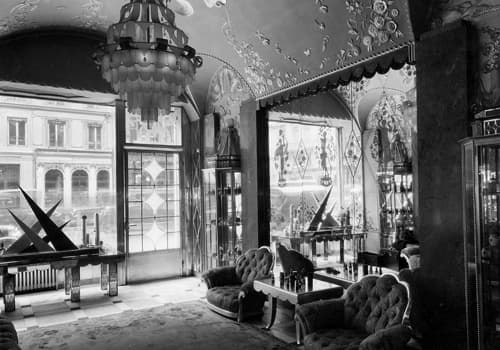
Above: 1932 Looking through the front window at 20 Rue de la Paix (Smithsonian).
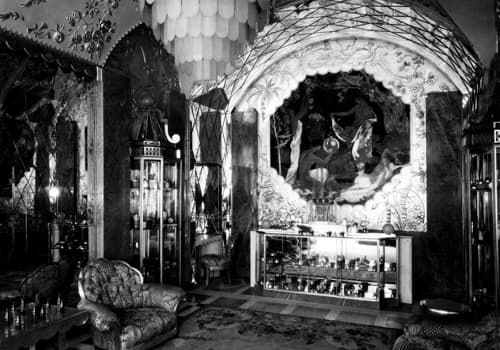
Above: 1932 Interior of the Richard Hudnut shop at 20 Rue de la Paix, Paris with mural decorations by Georges Barbier [1882–1932] (Smithsonian).
Production in Britain did not happen until 1932 when Richard Hudnut Ltd. commenced production of Hudnut toilet preparations at 300-302 Gray’s Inn Road, London. Products from William R. Warner & Co. Ltd. were also made there.
In 1930, Richard Hudnut celebrated its 50th Anniversary. This was a bit of a cheat as they took the date of Hudnut’s first perfume as the foundation date (1880) rather than the opening of his pharmacy (1899).
Also see the booklet: 1880-1930 Richard Hudnut book of values (c.1930)
Product lines
Richard Hudnut built his reputation on his perfumes along with their ancillary products such as a toilet waters, sachets, talcums, face powders, soaps or bath salts. Like French perfumers, such as Guerlain and Bourjois, these ancillaries often extended to face powders and rouges packaged in compacts and other accessories.
The new owners of Richard Hudnut continued this tradition into the 1920s, displaying ‘Richard Hudnut Perfumer’ or ‘Richard Hudnut Parfumeur’ at the bottom of much of their limited advertising. New perfumes were developed – presumably by Hudnut’s long-term, resident perfumer, Henry G. Dusenbury – along with accessories. For example, the Deauville fragrance (1923) came in perfume, eau de toilette, face powder, talcum powder and bath salts as well as single and double compacts and lipsticks.
Like Coty, Richard Hudnut produced a wide variety of lipstick cases in silver, gilt and coloured finishes, most of which used standard push-up or twist-up mechanisms.
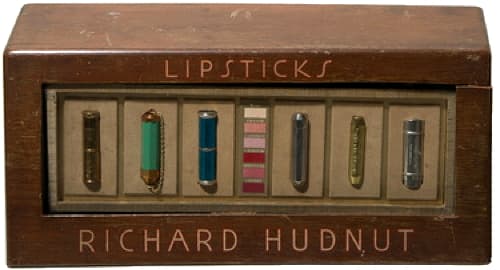
Above: Richard Hudnut lipstick display case with shade chart.
A few of these cases, although not successful in the long run had interesting mechanisms. The Handee case introduced in 1927, but apparently discontinued in 1928, was an unusual variation of the push-up type. The cap swivelled to act as the push-up mechanism but could also be used as a stand. A second case, introduced in 1932, was a cap-less automatic that used a twist-up mechanism to expose the lipstick.
As the beauty industry boomed in the United States during the 1920s it must have become increasingly clear that the company’s skin-care and make-up ranges left much to be desired. Hudnut had been producing skin creams for many years – Marvelous Cold Cream, Cucumber Cold Cream, Milk of Cucumbers and Orris, Crême Violet Sec and Toilet Cerate – but they were not integrated into a comprehensive cosmetic system and this became a focus for the company between the two world wars.
Richard Hudnut’s first integrated skin-care and make-up range was the Three Flowers line. This was followed by an extension of the Du Barry range, after which came the introduction of Gemey and Marvelous. The development of all these lines led to a great deal of product duplication, something Hudnut was very familiar with. The duplication is very noticeable in make-up items such as lipstick, rouge and face powder with many shades found in all four ranges.
Three Flowers
Three Flowers (1915) was one of the cheaper fragrances in the Richard Hudnut range. Despite its name, it was compounded with more than three flower essences, the main extracts being roses, orchids, lilies, and violets. Like other Richard Hudnut perfumes, it was also used to scent a number of ancillary products including a sachet, toilet water, talcum powder, bath crystals, face powder, lipstick and compacts before the company extended the line.
Skin-care
Three skin creams – Three Flowers Special Cleansing Cream, Three Flowers Skin and Tissue Cream, and Three Flowers Vanishing Cream – were added to the Three Flowers range in the early 1920s. The Three Flowers Special Cleansing Cream was to be used instead of soap; the Skin and Tissue Cream was a type of ‘skin food’ to be used overnight to nourish the skin and prevent wrinkles; while the Vanishing Cream was applied as a day cream to act as a skin protectant and powder base.
Three Flowers Special Cleansing Cream: “Penetrates the pores, entirely clears them of the day’s dust and grime, and leaves the skin soft, smooth and fresh.”
Three Flowers Skin and Tissue Cream: “[W]ill keep the tissues and pores of the skin in a vigorous condition and ensure firm, youthful contours.”
Three Flowers Vanishing Cream: “The mission of the cream is to protect and finish. Apply lightly to the face and all the shine is gone, all the little roughnesses have vanished. Now the powder will cling evenly, softly, for hours, to the velvet-smooth surface of your skin.”
Also see: Vanishing Creams
Initially, the morning Three Flowers skin-care routine used clear, cold water to rinse off any remaining Skin and Tissues Cream but, by the end of the decade, water had been replaced with a new product – Three Flowers Skin Freshener.
Three Flowers Skin Freshener: “To remove excess cream and close the pores.”
The addition of the Skin Freshener was integrated into a simple skin-care routine very similar to those suggested by other cosmetic companies.
First . . . . with an upward motion of the fingertips, stoke on Three Flowers Cleansing Cream. Remove with cleansing tissues.
Then . . . . gently pat over the face a bit of absorbent cotton saturated with Three flowers Skin Freshener, to remove excess cream and close the pores.
Next . . . . pat in Three flowers Skin and Tissue Cream to lubricate the skin and keep it soft.
And . . . . each morning, before using Three Flowers Face Powder, put on a protective base of Three Flowers Vanishing Cream, to give a smooth finish and insure adherence of powder.(Three Flowers brochure, c.1930)
Also see: Skin Tonics, Astringents and Toners
By 1926, the company had added a Hand and Face Lotion to be used after washing the hands or for chapped skin.
Three Flowers Hand and Body Lotion: “It restores the natural oils that keep the hands young and firm. Moreover, it is an excellent remedy for chapped skin—both on hands and face.”
Make-up
The Three Flowers make-up range included the usual loose and compact powders along with a compact rouge. When first introduced, the Three Flowers Face Powder came in the standard Hudnut shades of White, Flesh and Brunette (Rachel) extended, as with other Hudnut powders, with the addition of a darker brunette shade by the end of the decade. All these powder shades could be added to a Loose Powder Vanity. If women elected to buy Three Flowers Compact Powder this was only available in White, Natural and Brunette (Rachel).
Three Flowers Face Powder: “It has a wonderful odor—is smooth and really sticks to the skin—motoring will not blow it off.” Shades: White, Natural, Rose, Brunette (Rachel) with Parisian (Dark Brunette) added later.
At first, Three Flowers Rouge was only available as a compact in Natural, Pale (Light), Medium, Dark and Orange shades with Nasturtium, Carmeen, Geranium, Crimson and Stage shades added by 1930. By then, Three Flowers Cream Rouge had been introduced in Carmeen, Crimson, and Cherry shades. The Three Flowers Lip Sticks produced at this time also only came in three shades – Carmeen, Cherry Red, and Orange, with Crimson added by 1930.
The only other make-up items in the Three Flowers range available in the 1920s were Three Flowers Eyebrow Crayons and Pencils both made in Black, Brown and Chestnut shades.
Also see the booklets: The Secrets of Beauty (c.1923) and How to be Charming (c.1927)
Gemey
Based on the Gemey perfume (1924), the Gemey line originated in France and was reputedly available there from around 1929 before being released into the United States in 1931. Reports are that its development was a personal project of Charles Leonard Pfieffer [1896-1958], vice president of Richard Hudnut.
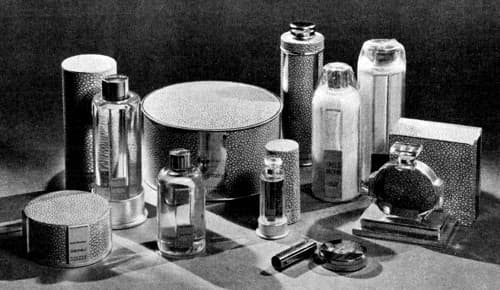
Above: 1931 Richard Hudnut Gemey. The tan and brown mottled effect of the packaging was produced by printing fine, brown lines on a rose-tan background. It was only broken by a vertical silver band displaying the product name, Gemey and Richard Hudnut.
Promoted as a prestigious Parisian line, the range started out with a perfume and toilet water along with a face powder, lipstick and rouge with the only skin-care cosmetic offered being Gemey Cucumber Cleansing Lotion. Other products in the line included Gemey Dusting Powder, Gemey Talcum Powder, and Gemey Brilliantine.
Gemey Face Powder: Shades: White, Naturelle, Brunette (Rachel No. 1), and Dark Brunette (Rachel No. 2).
Gemey Lipstick: Push-up type. Shades: Carmeen, Orange, Crimson, Cherry, and Rose.
Gemey Compact Rouge: Shades: Carmeen, Orange, Geranium, Nasturtium, Medium, Radiant Red, Petal Pink, and Stage.
Gemey Cucumber Cleansing Lotion: “A liquid cream that penetrates the pores and thoroughly cleanses them.”
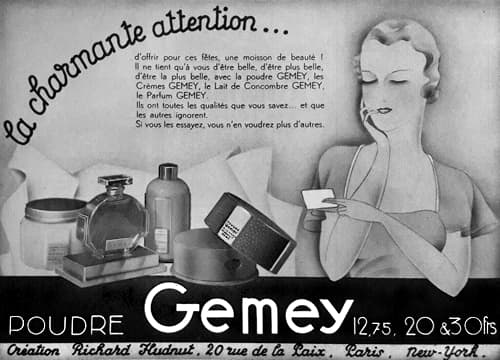
Above: 1935 Richard Hudnut Poudre Gemey (France).
Gemey make-up came in a greater range of shades than was available in the Du Barry line at the time. The meagre skin-care line would be extended later and Gemey would go on to develop a good following in France and elsewhere.
Marvelous
Marvelous perfume (1908) was not, as far as I can tell, used to scent a powder in Richard Hudnut’s time but was closely associated with Hudnut’s Marvelous Cold Cream.
When they debuted in 1932, the creams in the new Marvelous range were packaged in white glass jars with silver-finished, metal tops and silver labels marked with black lettering and a narrow scarlet border at the bottom displaying the word Marvelous. Other Art Deco inspired features included a stylised kneeling woman used as an emblem. These elements were repeated on other Marvelous packaging giving the whole line a very modern feel.
The early Marvelous product list included:
Marvelous Cold Cream: “[A] cleansing cream, a soothing cream, an all round satisfying cream, for general, everyday use.”
Marvelous Liquefying Cream: “[L]ight in texture, silky to your touch, soothing and kind to your skin.”
Marvelous Skin Freshener: “[T]hat pleasant paradox, a soothing astringent, stimulating and refreshing, soothing to the most delicate skin.”
Marvelous Tissue Cream: “[R]ich and luscious—a cream that does wonders for heat-fried and wind chapped faces, that relaxes taut tissues, improves necks.”
Marvelous Foundation Cream: “Soft fragrant smooth—protects your skin, holds powder tenaciously, ends nose an cheekbone shine.”
Marvelous Hand Cream: “To smooth, soften, whiten your hands, to ward off cracks, control cuticle, keep your fingertips free from grime.”
Marvelous Face Powder: Shades: White, Naturelle, Brunette (Rachel No. 1), and Dark Brunette (Rachel No. 2).
Marvelous Compact Face Powder: Shades: Natural, Peach, Rachel, and Tan Rachel.
Marvelous Cream Rouge: Shades: Carmeen, Crimson, Cherry, Nasturtium, Perpétuel (Indelible) and Rose.
Marvelous Compact Rouge: Shades: Carmeen, Orange, Geranium, Nasturtium, Medium, Radiant Red, Petal Pink, and Stage.
Marvelous Lip Stick: Push-up type. Shades: Carmeen, Orange, Crimson, Cherry, and Rose.
Marvelous Lash Cosmetic: Shades: Black, Blue, and Brown.
Marvelous Eye Shadow: Shades: Blue, Brown, Gray, Green, and Violet.
Marvelous Mascara: Shades: Black, Blue, and Brown.
Marvelous Nail Enamel and Remover: in combination.
There were many similarities between the Marvelous and the Gemey lines, most clearly evident in the shade ranges, which were identical, and in the compact and lipstick cases which seem to have used the same moulds. Like the Gemey line, the emphasis was on make-up but the Marvelous range had more skin-care cosmetics namely Marvelous Liquefying Cream, Marvelous Skin Freshener, Marvelous Tissue Cream, and Marvelous Foundation Cream.
Priced below Du Barry and Gemey, the line may have been developed in response to the deteriorating economic circumstances of the 1930s for customers with a limited budget. Significantly, there was no attempt to include a perfume or toilet water with this cheaper line and the metal lipstick and compact cases were made in a silver-tone finish rather than the gold tone used with Gemey.
The Marvelous line seems to have been limited to the United States but an almost identical range, simply called Richard Hudnut, was introduced into Britain in the 1930s. The British version of Marvelous was sold in black containers with a prominent red stripe, with compacts and lipsticks in a silver-tone finish as was the case with the American Marvelous line.
Although the shades in the make-up range were initially geared to skin types, from around 1936 the British Richard Hudnut line and the American Marvelous line were promoted as Eye-Matched Make-up, with eye colour advertised as the key to a person’s ‘Personality Colour’.
YOUR PERSONALITY COLOUR
This key to your type shows why, in dress, you have always instinctively chosen colours becoming to your Eyes; as with Dressing—so with Makeup: Here is the sure guide. Now Richard Hudnut have created Eye-Matched Makeup . . . Face Powder—Rouge—Lipstick—Eye Shadow and Mascara in shades that blend . . . keyed in turn to Brown, Blue, Hazel and Grey Eyes — shades correct together for you.(Richard Hudnut advertisement, 1939)
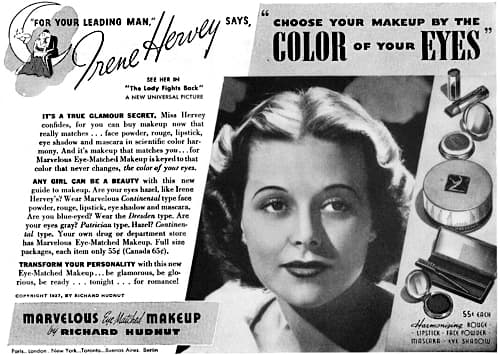
Above: 1937 Marvelous Eye-Matched Make-up.
Also see the booklet: New loveliness for you (c.1935)
Du Barry
Du Barry was a premium perfume created by Richard Hudnut in 1902 which also came as a sachet, and an eau de toilette. Like other Hudnut fragrances it was also used to scent face powders, toilet powders, bath powders, soaps, and compacts.
Also see the booklet: The Book of Du Barry (1923)
Hudnut began to expand the Du Barry range in the 1920s adding Du Barry Beauty Lotion, Du Barry Contour Cream, Du Barry Foundation Cream and Du Barry Cream Rouge by 1927. The Du Barry Beauty Lotion may have contained zinc oxide to act as a soother and astringent. The Du Barry Contour Cream was likely a type of cold cream to be used as a cleanser during the day or a ‘nourishing’ cream at night. The Du Barry Foundation Cream was a vanishing cream which came in two varieties, one of which was flesh coloured.
Du Barry Beauty Lotion: “A soothing lotion for soothing and beautifying the skin. Indispensable for a youthful complexion as well as for beautiful arms, soft elbows and smooth, white hands. Its astringent properties strengthen and invigorate the pores and help maintain a healthful skin of velvety smooth texture.”
Du Barry Contour Cream: “An exceptionally rich and fragrant preparation, combining the properties of a cleansing cream with those of a skin and tissue builder. Penetrates the pores and rids them of impurities. Tones, softens and beautifies the skin. Contains rare ingredients that are quickly absorbed rounding out every little line or hollow, and imparting youthful contours to the face.”
Du Barry Foundation Cream: “Luxuriously rich, yet light and delicate, this lovely cream protects the delicacy of the skin from the effects of wind and sun, and provides an excellent foundation for Du Barry Face Powder.” Shades: White, and Flesh.
Du Barry Cream Rouge: “Decidedly new and individual. Instantly applied; gives a charming and perfectly natural appearance. Applied to the lips, it keeps them soft and radiant, with the natural glow of youth.
Also see the booklet: Du Barry Beauty Preparations (c.1927)
In 1929, Hudnut added a number of new items to turn Du Barry into a complete skin-care and make-up range. Some of the new additions were similar to those already found in other lines but others were new. As well as expanding the line, Hudnut also began repackaging it and it became the company’s premier skin-care and make-up brand in the United States from here on.
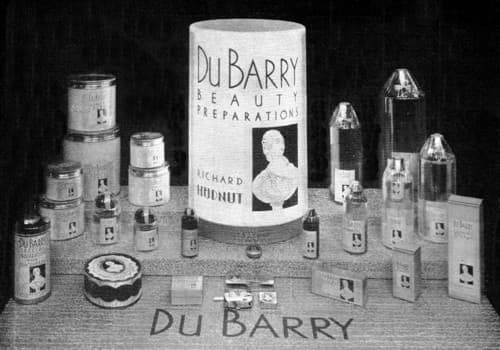
Above: 1932 Richard Hudnut Du Barry Beauty Preparations.
The Du Barry line was largely restricted to the United States. There are indications that it was introduced into Europe in the late 1930s but its presence there was cut short by the Second World War. Britain and the the countries of the British Empire were off limits as Dubarry et Cie was established there in 1916 and was selling Dubarry cosmetics. William Warner & Co. Ltd. of England went on to acquire a later version of this company in 1962.
See also: Dubarry et Cie
Skin-care
Although extended, the 1930 Du Barry skin-care range was still relatively limited, consisting of only a single cleanser, two skin foods, two skin tonics/astringents, a muscle oil, and a hand cream along with three specialist treatment preparations, a Pore Cream, an Eye Lotion, and a Special Preparation for Blackheads.
Du Barry Special Cleansing Cream: “ May be used any time—liquifies instantly, frees skin of dust and imperfections.”
Du Barry Skin Tonic and Freshener: “A mild astringent which contains a special ingredient for dissolving all traces of Cleansing Cream.”
Du Barry Tissue Cream: “Basic Cream for use in DU BARRY hand method treatments. For normal or oily skins; for plump face even if skin is dry. Non-fattening.”
Special Skin Food: “Basic Cream for treating the dry skin and thin contour.”
Du Barry Special Astringent: “for subduing oiliness of the skin. Also refines the texture.”
Du Barry Muscle Oil: “Basic Oil for use in DU BARRY hand method treatments—slightly astringent—timulates the tissues.”
Du Barry Eye Lotion: “a refreshing, soothing preparation for the eyes. Specially helpful for fatigued eyes”
Du Barry Pore Cream: “Soft, refining cream that contracts the pores overnight.”
Du Barry Special Preparation for Blackheads: “A pleasant, scientific prepared powder for correcting blackhead condition. Makes a paste mixed with a little water.”
Du Barry Hand Beauty Cream: “A softening whitening cream for the care of the hands. No sticky after-effect.”
Some recognition was made for different skin types – oily and dry – and this introduced a few minor differences in the recommended skin-care treatment plans.
Oily Skin
Morning Treatment:
1. Cleansing Cream.
2. Skin Tonic and Freshener (for removing traces of the cream). Note: Soap and warm water may be used to remove cream in preferred.
3. Special Astringent (patted on face with cotton pads).
4. Foundation Cream (for powder base. Follow with cream rouge or compact rouge, powder, lipstick)
Night Treatment:
1. Cleansing Cream.
2. Skin Tonic and Freshener.
3. Tissue Cream— Non-fattening (for Hand Method Treatment.
4. Special Astringent.Dry Skin
Morning Treatment:
1. Cleansing Cream.
2. Skin Tonic and Freshener (for removing traces of the cream).
3. Foundation Cream (for powder base. Follow with cream rouge or compact rouge, powder, lipstick)
Night Treatment:
1. Cleansing Cream.
2. Skin Tonic and Freshener.
3. Skin Food and Muscle Oil (for Hand Method Treatment.Richard Hudnut, 1930, pp. 24-25)
Du Barry Hand Principle
Du Barry did not recommend steaming but, as with other beauty treatments of the time, physical manipulation in the form of massage and strapping formed an important part of a Du Barry facial treatment. Rather than using a mechanical aid like a vibratory massager or patter, a hand massage was recommended, dressed up as the Du Barry Hand Principle.
Supposedly developed by Doris Hale, the Hand Principle routines – which were nothing out of the ordinary – were combined with Du Barry cosmetics to cleanse and tone the skin, treat enlarged pores and blackheads, reduce lines and wrinkles, and lift sagging contours. I have not found any evidence that Doris Hale existed; like Madame Jeanette of Pompeian or Jeanne Armand of Armand she may have been a creation of the marketing department.
If you follow the simple rules of the hand principle, your skin will not grow old before its time. Pore enlargement, lines, dropping contours, rough texture and loss of color can be corrected by this natural skin beautifying method.
(Richard Hudnut, 1930, p. 7)
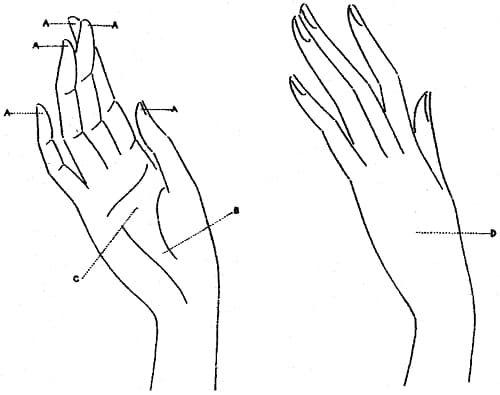
Above: 1931 The Du Barry Hand Principal Chart.
A. Cushion Tips of fingers. For applying lotions, smoothing
out fine lines from neck and face.
B. Palm Cushion, sometimes called “the heel of the hand.” For restoring jaw line contours, restoring firm chin line.
C. Palmar Muscles—for sagging cheeks—smoothing out horizontal forehead lines.
D. Dorsal Region of hand. Strong bony surface for reducing fat
and muscle tissue in underchin area.
The Du Barry skin-care range was static during the early years of the depression while Richard Hudnut was adding the Marvelous and Gemey lines but picked up after 1935. These included: Du Barry Stimulating Cream (1936), Du Barry Derma-Sec Formula (1936) for dry skin, Du Barry Eye Cream (1936), Du Barry Rose Cream Mask (1936), and Du Barry Cleansing Cream for Dry Skin (1938).
Du Barry Derma-Sec Formula: “A skillful blend of carefully chosen emollient oils and stimulating properties that help relieve the tendency toward excessive dryness of the skin. It is an extra rich cream especially recommended for use on the throat. Does away with that ‘taut’ feeling.”
Eye Cream: “A rich unperfumed cream to help smooth and soften the tender area near the eyes. If you want tour eyelids to shine but prefer not to use eyeshadow in the daytime, this lovely cream gives the lids a ‘dewy’ appearance without being sticky or uncomfortable.”
Du Barry Rose Cream Mask: “A fragrant, velvety mask with a cream base, it acts as a quick beauty pick up and a restful relaxation for tired faces and gives the quick fresh beauty of a radiant skin.”
Du Barry Cleansing Cream for Dry Skin: “[L]ight cream, with a fluffy texture particularly comforting to dry sensitive skin. Lightly perfumed, it contains a light lubricant that softens as it cleanses; quickly removing dirt and make-up.”
A number of Du Barry skin-care products were also replaced or renamed due to the introduction of the American Food, Drug and Cosmetic Act (FD&CA) which was passed into law in 1938. This placed restrictions on the naming of products and the claims that could be made for them. Special Cleansing Cream became Special (Liquifying) Cleansing Cream, Contour Cream became Contour Cleansing and Lubricating Cream, and Skin Tonic and Freshener Lotion became Skin Freshener. It would also appear that Muscle Oil was renamed as Facial Oil, Du Barry Tissue Cream as Tissue Softening Cream, and Special Skin Food as Special Skin Cream.
By the 1940s the Du Barry skin-care routines were extended to include dry, oily-normal and combination skin types each with a four-step treatment program – Cleansing, Lubricating, Firming and Protecting. Du Barry preparations were combined with positioning the body in the ‘Beauty Angle’, an idea developed by Ann Delafield (a.k.a. May MacGregor) the directoress of the Du Barry Success School. This lowered the upper body and raised the lower body so that blood would rush to the head. The dry skin version is given as an example:
Du Barry Dry Skin Treatment
1. CLEANSING. Apply DuBarry Cleansing Cream for Dry Skin or if you prefer a liquifying cream use DuBarry Special Cleansing Cream. Smooth the cream gently over face and throat using an upward, outward motion. Remove with tissues. Dip a pad of cotton in cold water—press it dry—saturate it in DuBarry Skin Freshener, pat it over the skin, wiping off every last vestige of cream.
2. LUBRICATING. Smooth DuBarry Special Skin Cream over the face, using an upward and outward stroke. If the neck needs special attention smooth DuBarry Derma-Sec Formula over the throat, working with both hands from the upper chest to the chin to give this area extra lubrication. On the delicate dry areas around the eyes, place a little DuBarry Eye Cream.
Recline for as long as comfortable in the legs-up, head-down Beauty-Angle position to assist these exquisite emollient creams in their softening and smoothing action. If this treatment is taken at night the need for keeping the lubricating creams on overnight is obviated. You may remove them after the Beauty-Angle and next morning continue with your treatment using Skin Freshener.
3. FIRMING. Remove the lubricating creams with tissues. Wipe the skin clean with DuBarry Skin Freshener. Saturate a pod of cotton with DuBarry Firming Lotion and pat face and throat to firm the skin surface. In the daytime, pat the face and throat bristly to give it a fresh beauty under make-up.
4. PROTECTING. After using DuBarry Firming Lotion, apply the foundation of your choice while the skin is still fresh. Remember that a dry skin particularly needs protection. DuBarry Foundation Lotion should be used if your skin is sensitive. Or DuBarry Pink Foundation Cream if you prefer a cream. DuBarry Make-up Base is a tinted foundation that gives warm color to the skin. It helps conceal minor blemishes and is recommended for a longer-lasting make-up.(Richard Hudnut, 1941, pp. 12-13)
Provision was also made for teen-age skin, a cohort that would become more important after the war. The suggested routine did not included medicated preparations, relying instead on skin-care cosmetics used for other skin types.
At night gently scour with DuBarry Special Cleaning Preparation. Then if the skin tends to be dry, smooth a thin film of DuBarry Tissue Softening Cream over the face and gently mould with the fingers and palms of the hands. Thiis supplies just the amount of light, softening lubrication. Remove with tissues and pat briskly with DuBarry Skin Freshener on a pad of cotton. If the skin is noticeably oily, pat with DuBarry Special Astringent on cotton, over oiliest areas. You will find that these preparations exert a slightly contractual action on the skin surface. Girls just beginning to use face powder, should be cautioned always to apply a foundation forst as a complexion protector. DuBarry Beauty Lotion is a desirable foundation for skins of “Teen Age,” because it is slightly astringent and by its action helps reduce the excessive excretion of oil, Thus it holds powder on smoothly and evenly.
(Richard Hudnut, 1941, pp. 22-23)
Make-up
By 1930, Du Barry make-up range had been extended beyond face powder to include two foundations (cream and lotion), liquid powder, rouge (cream, liquid and compact), lipstick, eyeshadow, eyebrow pencil and mascara. The 1930 shade ranges for the coloured make-up items are listed below:
Du Barry Foundation Cream: Shades: White, and Flesh.
Du Barry Face Powder: Shades: White, Naturelle, Peach, Brunette, Light Tan, and Deep Tan.
Du Barry Cream Rouge: Shades: Carmeen, Crimson, Medium, Petal Pink, Geranium, Orange, Nasturtium, Radiant Red, and Stage.
Du Barry Liquid Rouge: Shades: Light, and Dark.
Du Barry Lipstick: Shades: Carmeen, Crimson, Cherry and Perpétuel (indelible).
Du Barry Eyeshadow: Shades: Blue, Brown, Grey, and Green.
Du Barry Eye Pencil: Shades: Black, and Brown.
Du Barry Lash Beauty (mascara): Shades: Black, Brown, and Blue.
Although the shade range of each piece of make-up was limited, the company did provide suggestions for shade selection based on skin and hair colouring for powder, rouge and lipstick, or on eye colouring for eyeshadow and mascara.
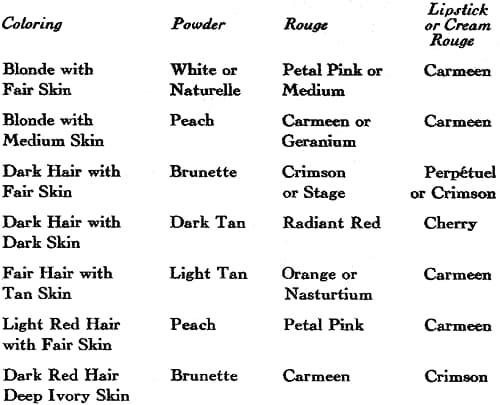
Above: 1930 Du Barry Make-up Chart.
Other shades were added through to 1935. By then, Du Barry Lipstick now came in six shades (Carmeen, Crimson, Cherry, Perpétuel (indelible), Rose, Orange and Nasturtium) which made it easier to match lipstick and rouge, Du Barry Liquid Rouge now included a Rose shade, and Green and Violet shades had been added to the Du Barry Eye Shadow.
After 1935, new make-up products began to be added across the Du Barry range.
Foundation and face powders
By the early 1940s, Du Barry had added Du Barry Make-up Base (1939) in a range of darker shades to its list of foundations and adjusted others so that allowances were now made for skin types.
Du Barry Foundation Cream, Pink (for dry skin): “Spreads beautifully; holds powder indefinitely; helps prevent a taut, drawn feeling by keeping the skin soft and fresh under make-up.”
Du Barry Foundation Cream, White (for normal skin): “It is a non lubricating preparation which forms a delicate film over the skin and holds powder for a long time. Keeps the skin fresh under make-up. Helps prevent shine.”
Du Barry Foundation Lotion: “An exquisite, fragrant milky lotion which contains just enough oil to keep the skin soft and dewy moist under powder.”
Du Barry Beauty Lotion (for the oily skin): “Helps arrest a tendency towards excessive oiliness and hold powder on smoothly and evenly. Ideal for adolescent skin and for ‘difficult’ complexions leaving them feeling clean but not sticky.”
Du Barry Makeup Base (for all types of skin): “This is an extraordinary, creamy foundation which delicately tints the skin, imparting a luminous glow to the complexion. Conceals freckles and minor blemishes and gives a glamorous, longer-lasting make-up.” Shades Light, Medium, Dark and Bronze.
The Du Barry Face Powder and Du Barry Powder Lotion remained staples but now came in a greater range of shades. New face powder shade additions after 1935 included: Tropical, Rose Beige, Special Rachel, and Riviera (1936); and Honey Beige and Champagne Beige (1940). By 1941, Du Barry Face Powder came in ten shades (Naturelle, Peach, Champagne Beige, Rose Beige, Honey Beige, Rachel, Rachel No, 2, Special Rachel, Tropical, and Morocco), with Du Barry Powder Lotion in six shades (Naturelle, Rachel, Light Tan, Deep Tan, Bronze, and Tropical).
Lipstick and rouge
Richard Hudnut introduced a number of different lipstick cases in the 1920s and 1930s but most Du Barry lipsticks in the 1930s were sold in caplok cases made by Scoville under a patent filed in 1933 (U.S. Patent No. 2,013,308: 1935). The cases prevented the lipstick turning when it was applied and this was promoted as stopping lipstick smears. Exactly when the cases were first employed is unknown to me but they were widely used, mostly in gold-tone finishes.
New Du Barry lipstick shades added after 1935 included: Regal Red (1936); Fuschia (1938); Peppermint Pink (1939); Barberry, American Beauty, and Red Flare (1940); and Red Gold, Emblem Red, and Rose Cerise (1941).
In 1930 Du Barry Compact Rouge came in Medium, Orange, and Carmeen shades while the Du Barry Cream Rouge exactly match the current Du Barry Lipstick shades (Carmine, Crimson, Cherry, and Perpetuel). New shades of rouge accompanied the addition of new shades of lipstick so that by 1941 Du Barry compact rouge now came in Red Gold, Barberry, Carmeen, Red Flare, Emblem Red, Crimson, Regal Red, Fuchsia, Peppermint Pink, Rose Cerise, Black Cherry, Petal Pink, Medium, and Stage, while Du Barry Cream Rouge was available in Red Gold, Barberry, Carmeen, Red Flare, Emblem Red, Crimson, Regal Red, Fuchsia, Peppermint Pink, Rose Cerise, and Black Cherry shades.
By 1941, Du Barry had also introduced Du Barry Rouge Parfait, a softer rouge, possibly an emulsion, in three shades.
Du Barry Rouge Parfait: “An easy blending cream rouge of a softer consistency: remarkably long lasting.” Shades: Light, Medium, and Dark.
Colour coordination
By the 1940s, Du Barry offered two colour coordination systems both widely used by other cosmetic companies. Personality Make-up was matched to skin tones.
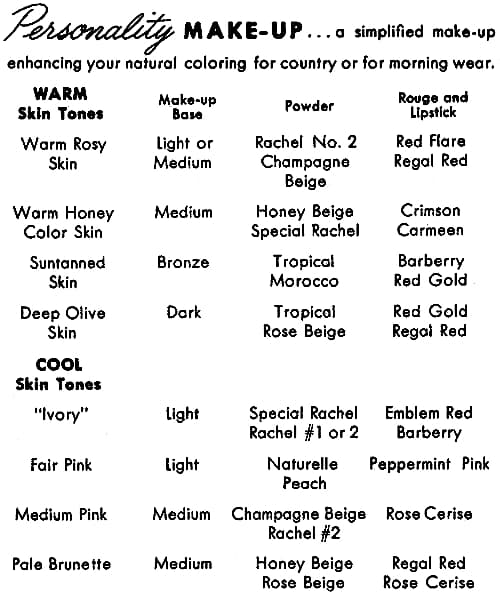
Above: 1941 Du Barry Personality Make-up.
Fashion Make-up was aligned with current fashion colours.
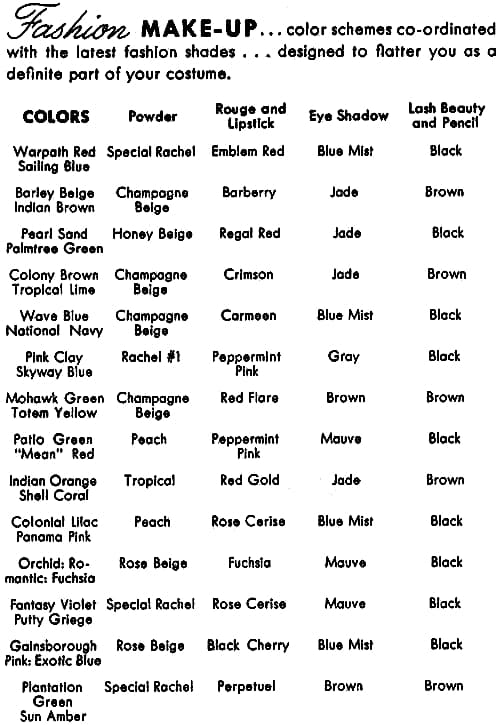
Above: 1941 Du Barry Fashion Make-up.
Also see the booklet: Beauty is Yours (1941)
Du Barry Success Course
Despite the introduction of new products and the extension of make-up shade ranges sales of Du Barry cosmetics remained disappointingly low until the Du Barry Success Course was introduced in 1940. The Success Course was a paid, six-week course sent through the mail, that covered diet, exercise, deportment, etiquette and beauty lessons. It came with a set of Du Barry skin-care and make-up cosmetics which helped promote the brand.
See also: Du Barry Success Course
The Success Course was developed from the Du Barry Success School which operated at the Richard Hudnut Du Barry salon in Fifth Avenue.
Salon
Although the shop at 20 Rue de la Paix, Paris was described as a salon I have no evidence that it was ever anything more than a showroom. During the 1920s it was managed by Charles Adrian Pennock [1892-1985] who later became the president of the Hudnut Sales Company.
The building at 693 Fifth Avenue, New York, which opened in 1931, did have a beauty salon. It appears to be the only one owned and operated by the company at the time.
Originally known as the Richard Hudnut Salon, after 1936 the Fifth Avenue salon was generally referred to as the Richard Hudnut Du Barry Salon. When described in 1935, the salon and shop extended over three floors. The first floor was used as a showroom where Richard Hudnut perfumes and Du Barry beauty preparations were available for sale.
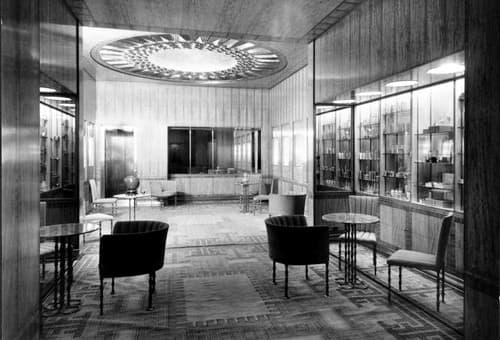
Above: 1931 The showroom at 693 Fifth Avenue, New York. Decorated with zebra and primavera wood casework with a terrazzo floor covered by a yellow and grey rug woven by Loja Saarinen [1879-1968]. At the back in the primavera ceiling there is a recessed gold dome trimmed in nickel silver.
The second floor contained a reception area leading into treatment rooms for facials, manicures and pedicures but also contained a Salon de Coiffure in the charge of Ferdinand who specialised in partial permanent waves.
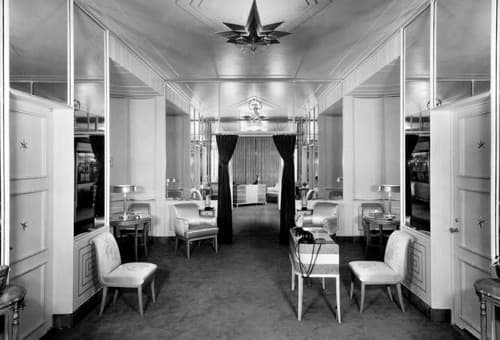
Above: 1931 The reception area at 693 Fifth Avenue, New York. Accessed by a private elevator this mirror-lined reception led into individual treatment rooms.
The third floor held a Slenderizing Department where unwanted pounds were exercised away on a Beauty Board, washed away in Du Barry Beauty Baths (wax baths) and/or massaged away by a masseuse. A Sports Roof was also set up on the top of the building sto enable women to take part in badminton, checker tennis, rope skipping, handball, punching bags, medicine ball throwing, or practice their golf strokes.

Above: Woman with badminton racquet on the roof of the Richard Hudnut Building.
By 1935, the salon was under the directorship of Ann Delafield (a.k.a. May MacGregor) who had come to Richard Hudnut from Elizabeth Arden. It was Ann Delafield who introduced the Beauty Boards used in the Slenderizing Department and the Right Angle or Beauty Angle face treatments that reclined the client at a slight angle so that blood flowed to her face. The increase blood flow to the face and neck during the tilt was said to obviate the need for slapping or patting but not strapping, thereby improving sagging contours, the appearance of lines, and sallowness.
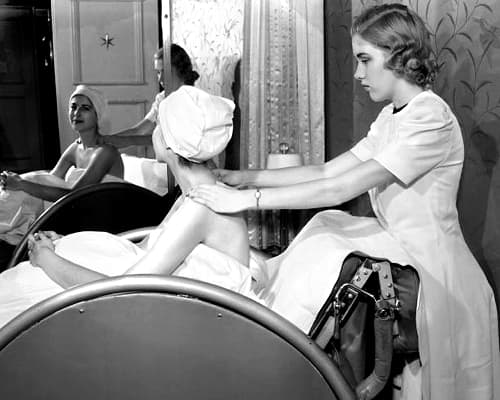
Above: Massage treatment in the Richard Hudnut salon. The Beauty Angle device has been folded to form a chair.
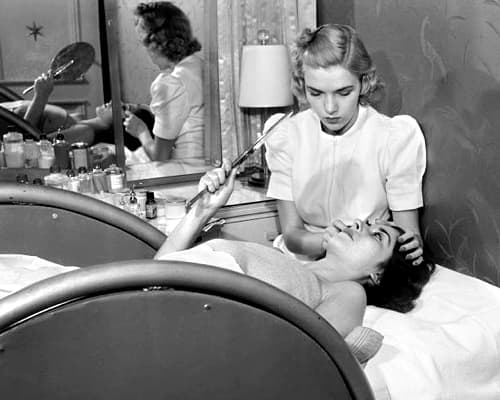
Above: Facial treatment in the Richard Hudnut salon. The Beauty Angle device has been converted into a bed. The head end could be dropped lower than this.
The Right Angle Face Treatment alone should be enough to make any woman an habituée of the Richard Hudnut Salon.
To say that it is different is to put it mildly, for this face treatment is absolutely revolutionary, from the minute you relax in the special scientific Chair, to the time you are pronounced “finished.” It is different in that your spine and nerve centers are massaged until every vertebra is relaxed and all tension is relieved. It is different in that you are inclined in this astounding Chair so that your feet are slightly higher than your head and the blood can flow naturally to your face.
When your face is thus in repose, in its youngest, most line-free state (you’re given a mirror to prove this), the “tie-up” best suited to your skin is applied. It is that angle of incline that is the secret of the effectiveness of this treatment. Hence its name!(Richard Hudnut advertisement, 1935)
The emphasis on improving circulation led to the addition of Du Barry Stimulating Cream in 1936 which “activated the circulation so that the skin can more easily throw off impurities”.
See also: Circulation Creams
Apart from the Right Angle Face Treatment there seems little else offered by the Richard Hudnut salon in the way of beauty treatments that would distinguish it from other salons of its time.
War
Wartime restrictions saw many Richard Hudnut products moved into wartime packaging using paper and plastic to replace metal and some reduction in make-up shade ranges.
There were a few minor developments. The company also released a leg make-up stocking replacer and a hand cream for female war workers. In 1943, Du Barry also added a new shade of lipstick, Red Violet, in a wartime cardboard container and Du Barry Beauty Cake Make-up in five shades, increased to seven by 1944. Beauty Cake appears to have been a pan-cake type of make-up similar to the one released by Max Factor in 1938. It could be applied with water but Du Barry recommended using Du Barry Foundation Lotion rather than water if the skin was dry.
Dermex Protective Cream: “ Dermez is a tried-and-tested protective cream especially formulated for the protection of women war workers’ hands. It keeps hands soft and smooth.
Du Barry Leg Make-up: “For sports, for-dress, for dancing in the moon-light, here’s the summer ‘stocking’ acclaimed by thousands.” Shades: Tropical, and Bronze.
Du Barry Beauty Cake: “Gives your skin that luminous look; protects it from wind and dust; takes only a minute to apply.” Shades: Light, Fair, Medium, Dark, Light Tan, Deep Tan, and Morocco.
Timeline
| 1920 | William R. Warner & Co. reincorporates in Delaware. Building at 115-117 East 29th Street sold. |
| 1921 | New store opens at 392 Fifth Avenue, New York. |
| 1922 | New Products: Twin compact patented by Ralph Wilson. |
| 1924 | New Products: Gemey perfume; and Deauville line. |
| 1925 | Factory and laboratory established at Surenes, Paris. |
| 1927 | Paris shop opened at 20 Rue de la Paix. New Products: Le Début perfumes. |
| 1929 | Du Barry line expanded and packaging modernised. New Products: Poudre Le Début. |
| 1931 | New York salon and shop opens at 693 Fifth Avenue. Gemey line introduced into the United States. |
| 1932 | British factory established at Gray’s Inn Road, London. New Products: Marvelous line; and Twist-up lipstick case. |
| 1936 | Marvelous ‘Eye-Matched Make-up’ campaign begins. New Products: Du Barry Stimulating Cream; Du Barry Rose Cream Mask; Derma-Sec Formula for Dry Skin; and Du Barry Eye Cream. |
| 1938 | New Products: Du Barry Cleansing Cream for Dry Skin. |
| 1939 | Richard Hudnut Success School starts. New Products: Du Barry Make-up Base. |
| 1940 | Du Barry Success Course starts. |
| 1943 | New Products: Du Barry Beauty Cake. |
Continued onto: Richard Hudnut (post 1945)
First Posted: 9th March 2015
Last Update: 18th February 2024
Sources
The American perfumer & essential oil review. (1906-1955). New York: Robbins Perfumer Co. [etc.].
The drug and cosmetic industry. (1932-1997). New York: Harcourt Brace Jovanovich [etc.].
Klein, H. G. (1974). A DCI company profile Warner-Lambert. Drugs & Cosmetics Industry, May, 46-48, 125-128.
Richard Hudnut. (c.1925). How to be charming [Booklet]. U.S.A.: Author.
Richard Hudnut. (1927). The way to lovely skin [Booklet]. New York: Author.
Richard Hudnut. (1930). Home method of Du Barry beauty treatments by the new hand principle as interpreted by Doris Hale [Booklet]. U.S.A.: Author.
Richard Hudnut. (c.1930). 1880-1930 Richard Hudnut book of values [Booklet]. U.S.A.: Author.
Richard Hudnut. (1935). Home method of Du Barry beauty treatments by the new hand principle [Booklet]. U.S.A.: Author.
Richard Hudnut. (c.1937). New loveliness for you [Booklet]. U.S.A.: Author.
Richard Hudnut. (1941). Beauty is yours . . . [Booklet]. U.S.A.: Author.
Wessels, W. L. (1961). Adirondack profiles. Lake George, N.Y.: Adriondack Resorts Press.
Woodhead, L. (2003). War paint: Miss Elizabeth Arden and Madame Helena Rubinstein. Their lives, their times, their rivalry. London: Virago.
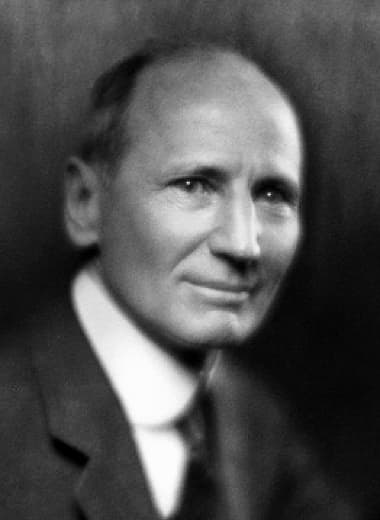
Gustavus Adolphus Pfeiffer [1872-1953]
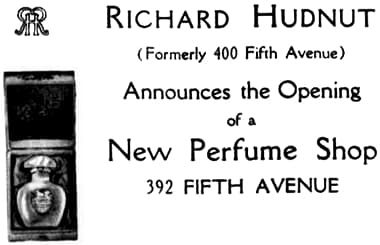
1921 New Shop announcement.
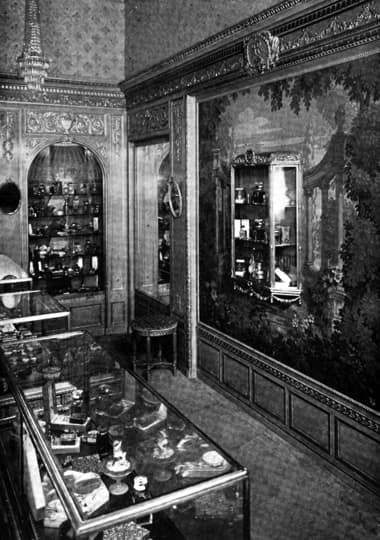
1922 Interior of the Richard Hudnut shop at 392 Fifth Avenue, New York.
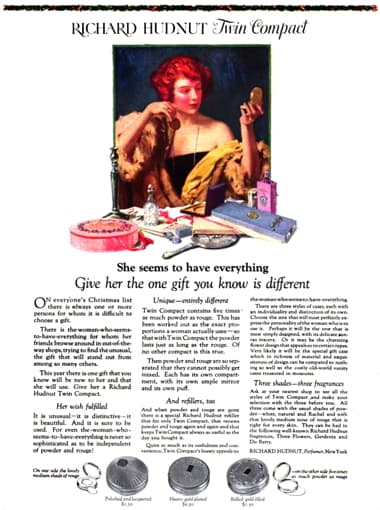
1922 Richard Hudnut Twin Compacts. Gilt lacquered case with Three Flowers powder and rouge; gold plated case with Gardenia powder and rouge; gold filled case with Du Barry powder and rouge.
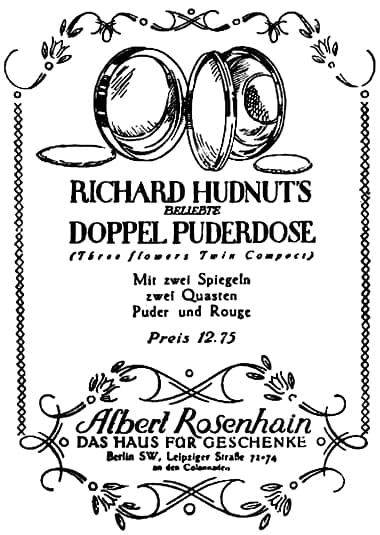
1925 Richard Hudnut Twin Compacts (Berlin).

Human model representing Three Flowers.

Handee lipstick case. This probably had a silver-tone finish when originally made.
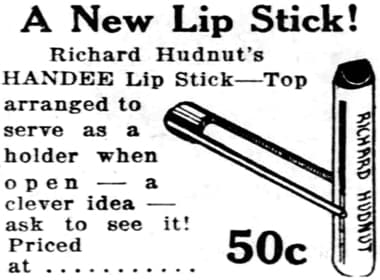
1927 Richard Hudnut Handee Lipstick.
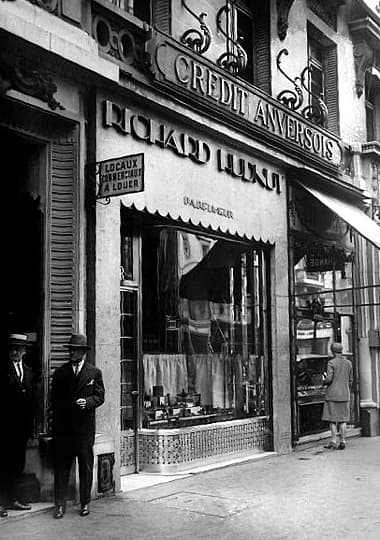
1928 Richard Hudnut Paris storefront in marble and green-painted wood with lettering in gold metal. Architect Jacques Débat-Ponsan [1882-1942].
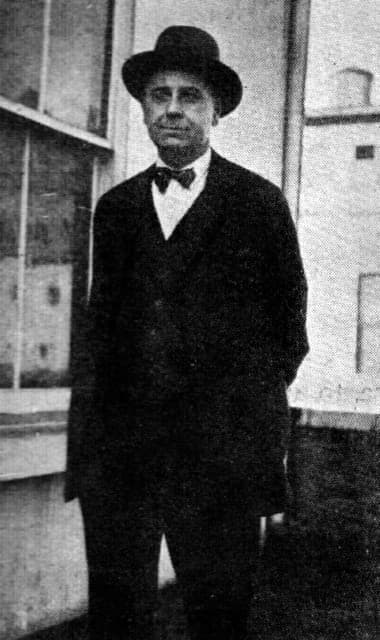
Henry Genet Dusenbury [1876-1939], Hudnut’s resident perfumer and company treasurer. He was with Hudnut for twenty-nine years until his retirement in 1938.

1928 Richard Hudnut Parfum Le Début, presumably developed by Henry G. Dusenbury. Formulated to celebrate the opening of a new Richard Hudnut Paris salon the perfumes were produced in France using bottles made by Cristalleries de Nancy. They came in four distinct fragrances to suggest four different moods: Le Début Vert, Adventure (green box); Le Début Blanc, Gaiety (white box); Le Début Noir, Sophistication (red box); and Le Début Bleu, Romance (blue box).

1929 Richard Hudnut Le Début Chatelaines.
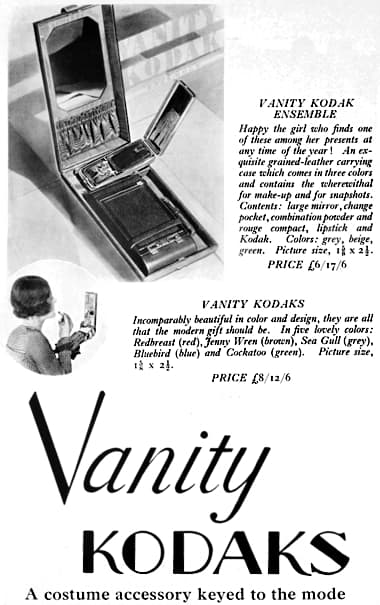
1929 Vanity Kodak containing a Kodak camera and Richard Hudnut powder, rouge and lipstick (Australia).
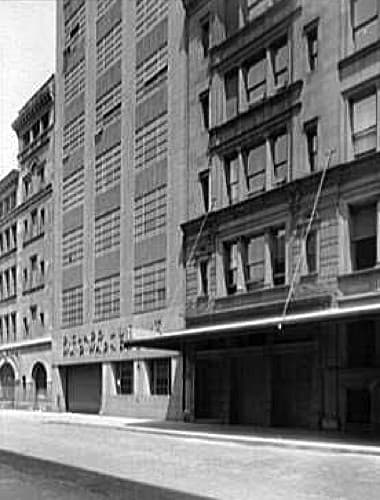
The eight-storey factory and loft building at 133 West 18th Street designed by George Abraham Boehm [c.1874-1959]. Covered in terracotta tiling, it extends through the block to 124 West 19th Street. The lettering on the building reads Richard Hudnut WM R Warner & Co. It was built in 1929-31 and still stands.
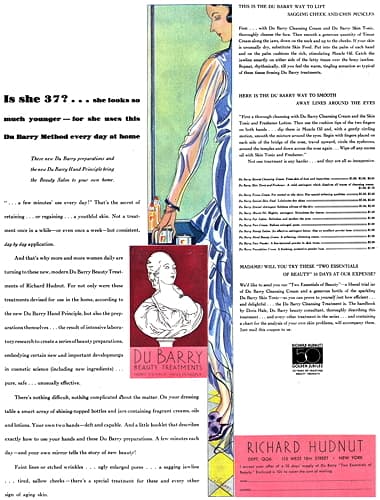
1930 Richard Hudnut Du Barry line.
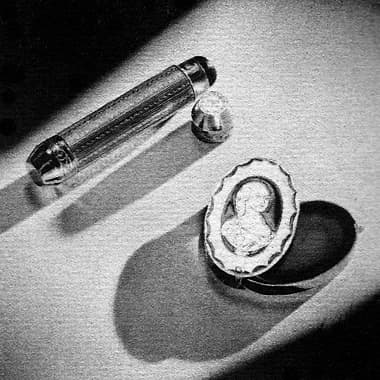
1930 Du Barry Lipstick and Cream Rouge.
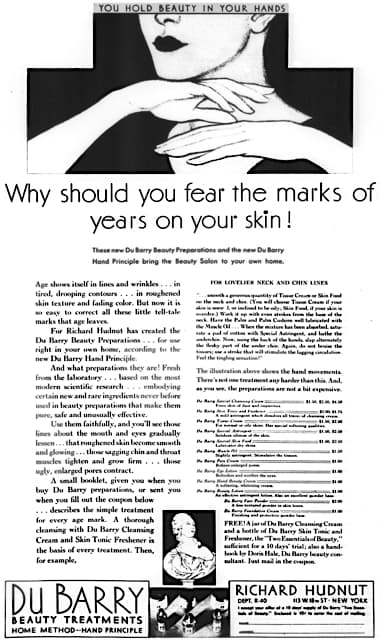
1930 Du Barry products.
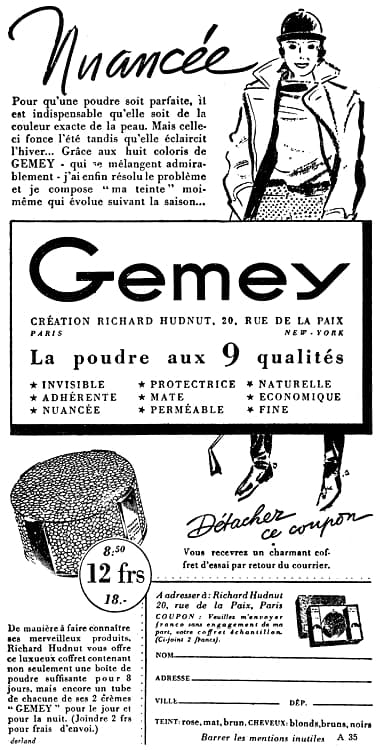
1930 Richard Hudnut Poudre Gemey.
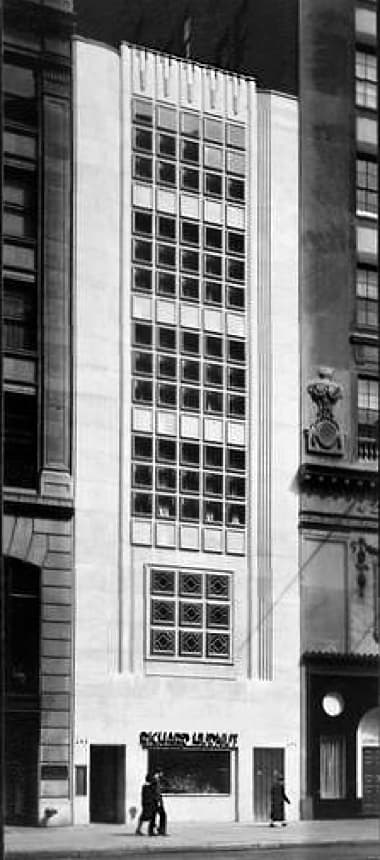
1931 Hudnut building at 693 Fifth Avenue, New York designed by Ely Jacques Kahn [1884-1972] and Eliel Saarinen [1873-1950]. The New York salon of Elizabeth Arden is next door.
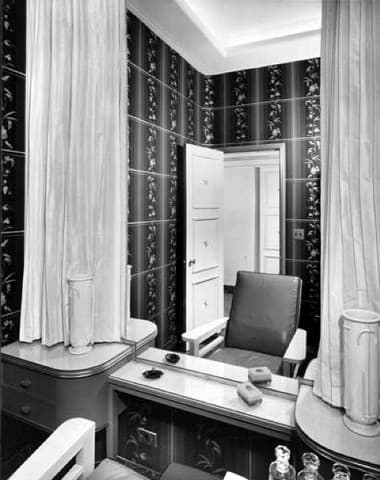
1931 A blue and silver decorated treatment room in the salon at 693 Fifth Avenue, New York.
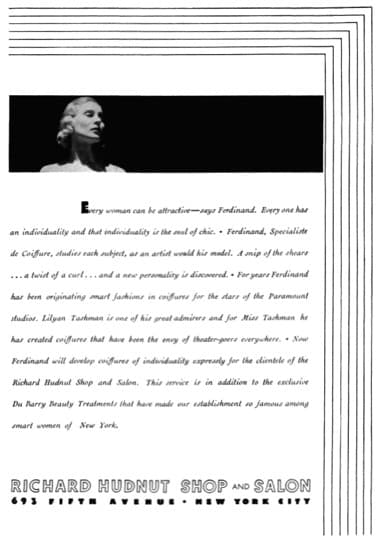
1932 Richard Hudnut Shop and Salon at 693 Fifth Avenue. New York.
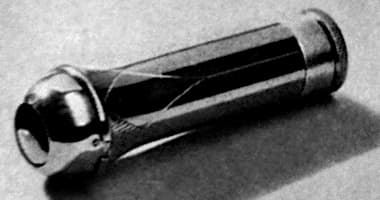
Above: 1932 Capless, automatic lipstick in a silver-tone case. Shades: Carmeen, Cherry, Rose, Crimson, Perpetuel, and Orange.
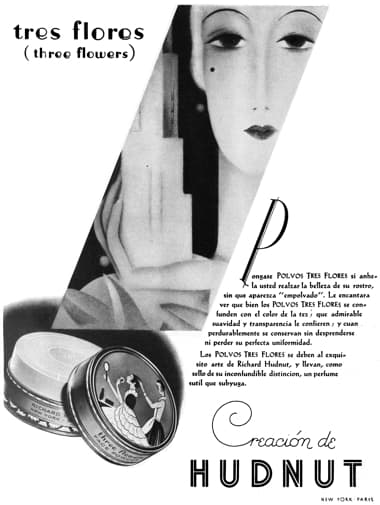
1933 Richard Hudnut Tres Flores (Three Flowers) Face Powder (Spain).
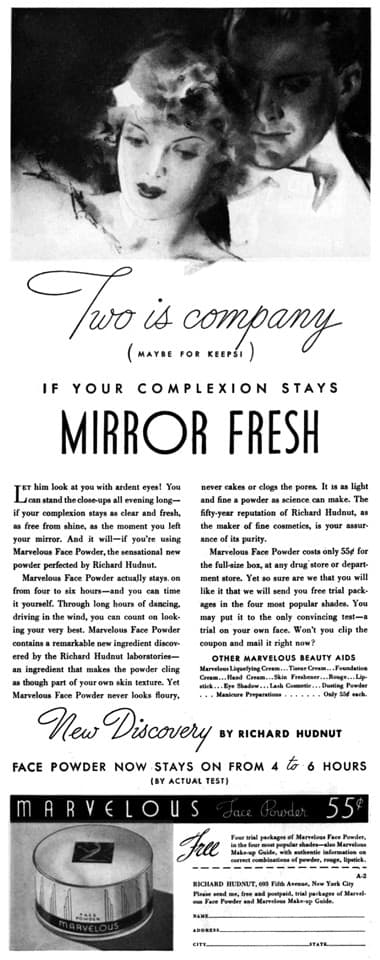
1934 Marvelous Face Powder.
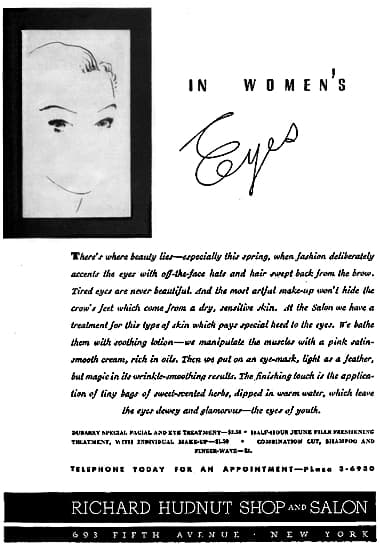
1934 Richard Hudnut Shop and Salon.
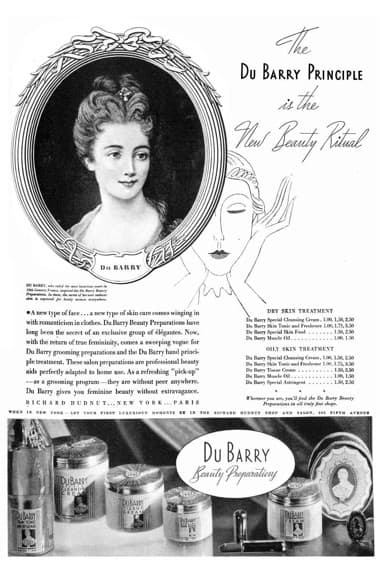
1934 Du Barry Beauty Preparations.
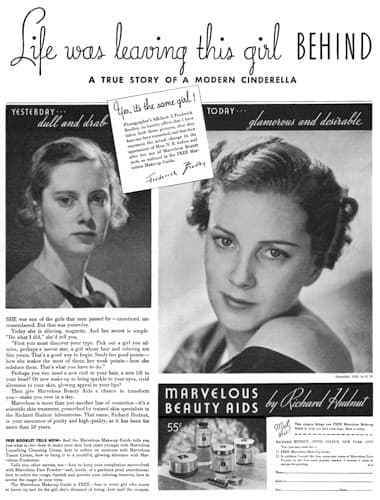
1935 Richard Hudnut Marvelous Beauty Aids.
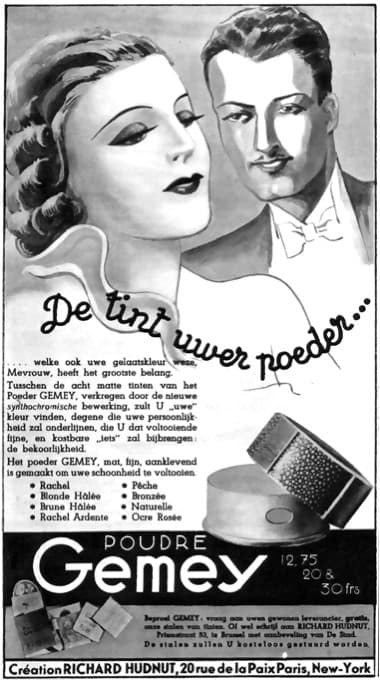
1936 Richard Hudnut Poudre Gemey (France).
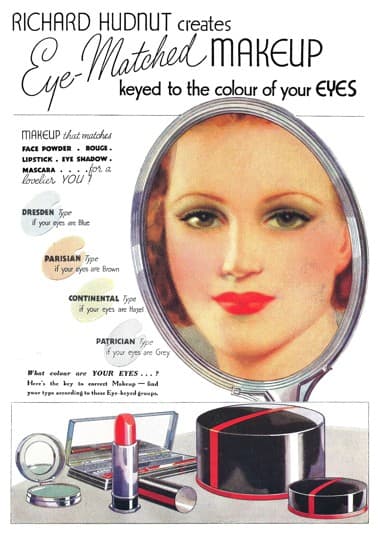
1936 Richard Hudnut (Britain). This British line was a near clone of the American Marvelous line and used the same idea of ‘Eye-Matched Makeup’.
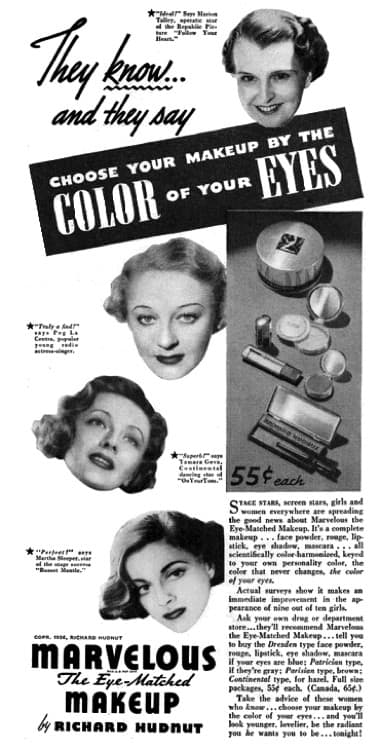
1936 Richard Hudnut Marvelous, the eye-matched make-up.
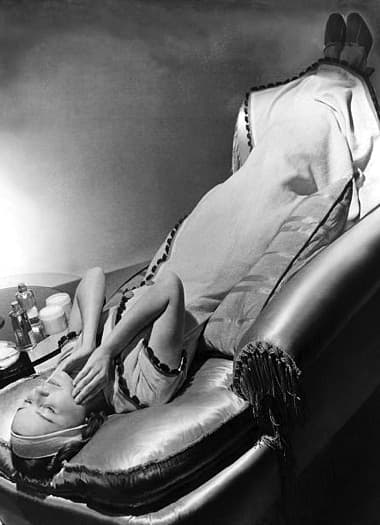
Above: 1936 Woman reclining at home in the legs-up, head-down Beauty-Angle position. This was said to bring extra blood to the face which would improve the complexion, reduce double chins, and make facial lines less visible.
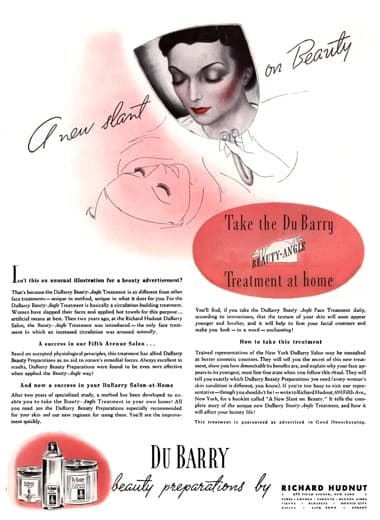
1937 Du Barry home treatments and the Beauty Angle.
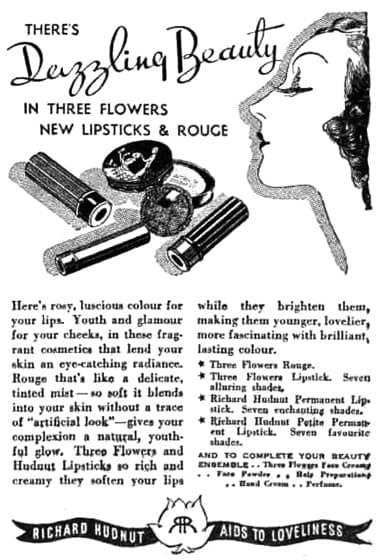
1937 Three Flowers lipsticks and rouge.
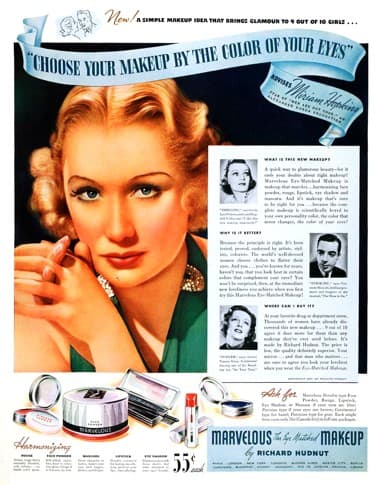
1937 Richard Hudnut Marvelous Make-up.
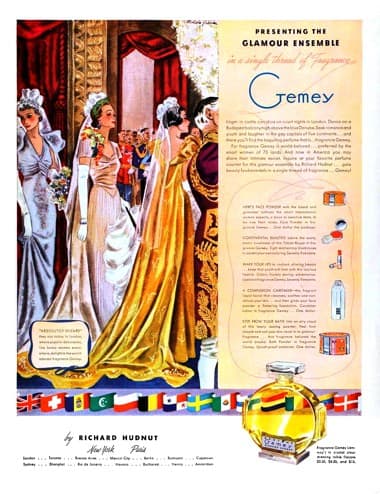
1937 Richard Hudnut Gemey Perfume.
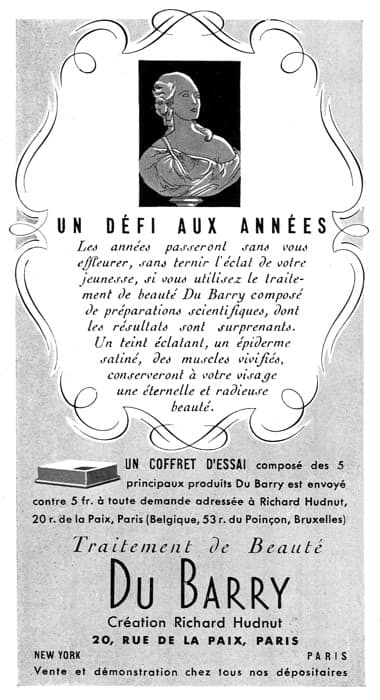
1938 Richard Hudnut Du Barry (France). The line was sold there prior to the Second World War before the company switched its focus to Gemey and Chen Yu.
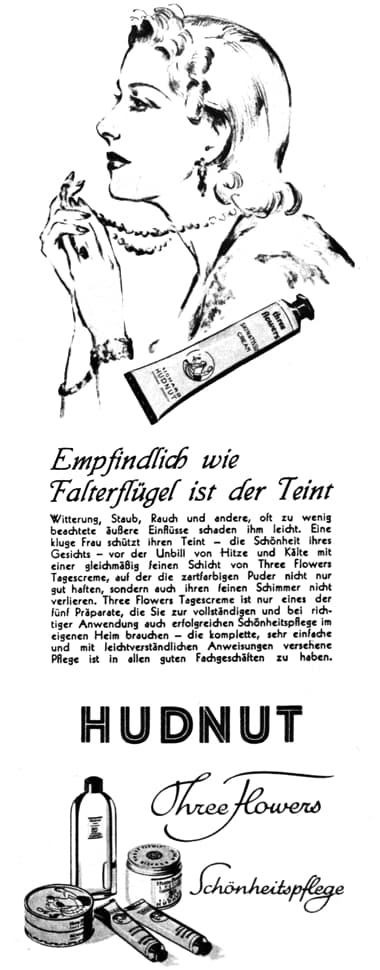
1938 Richard Hudnut Three Flowers (Austria).
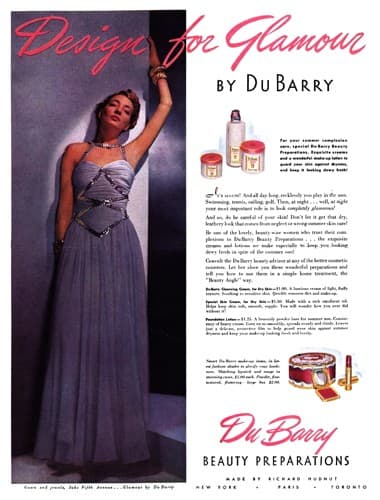
1939 Du Barry Beauty Preparations.
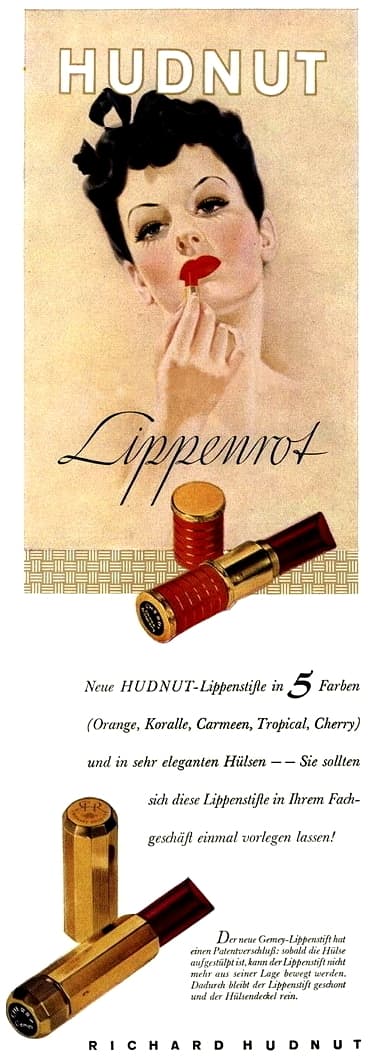
1939 Richard Hudnut Lipstick in plastic and gold-tone twist-up, and gold-tone caplok cases (Germany).
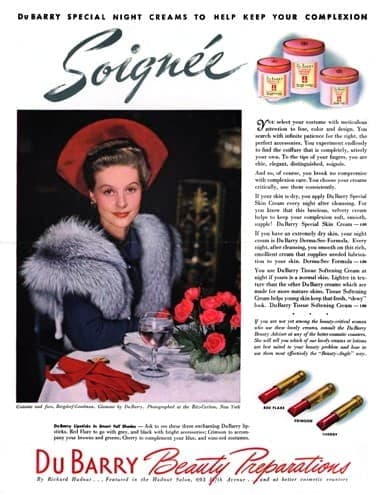
1940 Du Barry Beauty Preparations.
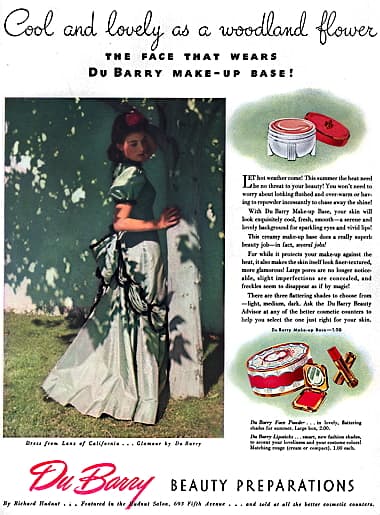
1940 Du Barry Make-up Base.
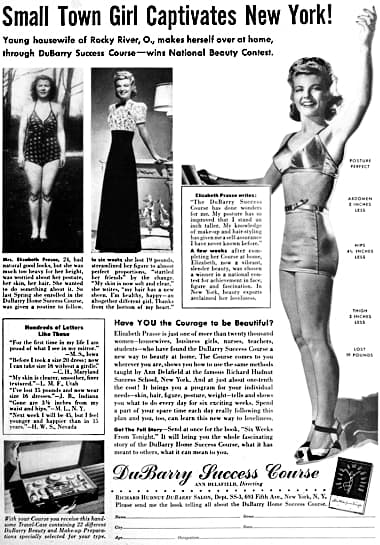
1940 Du Barry Success Course.
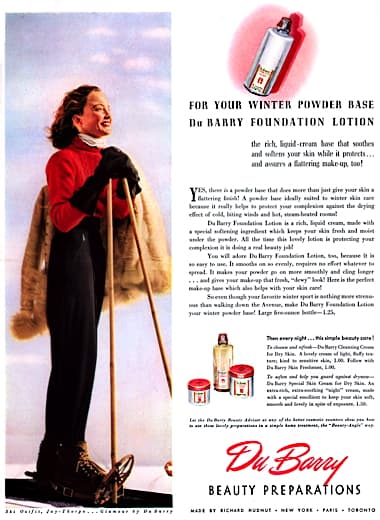
1940 Du Barry Foundation Lotion.
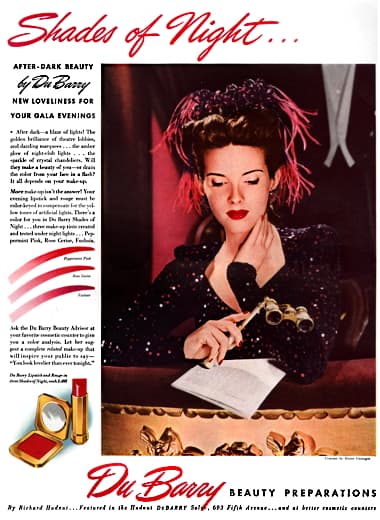
1941 Du Barry Peppermint Pink, Rose Cerise, and Fuchsia Lipsticks in caplok cases.
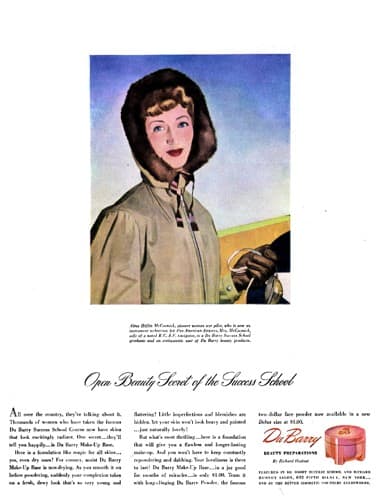
1942 Du Barry Make-up Base and the Success School.
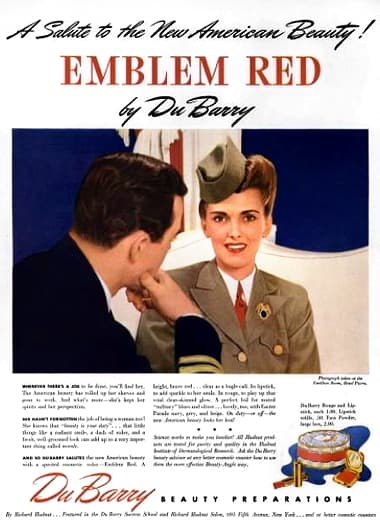
1942 Du Barry Emblem Red.
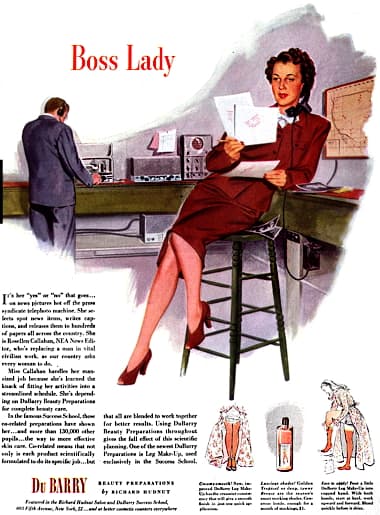
1944 Du Barry Leg Make-up.
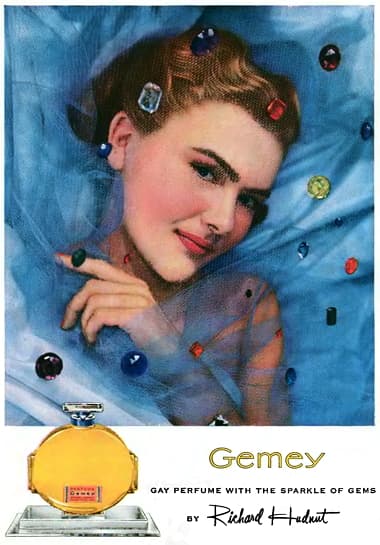
1944 Gemey.
